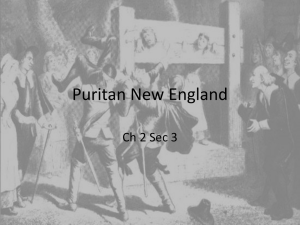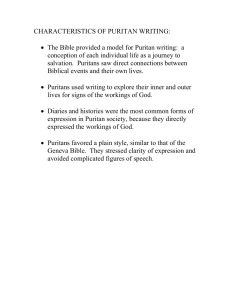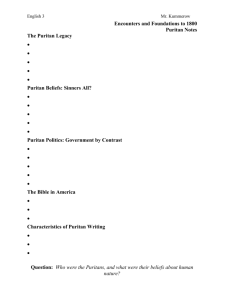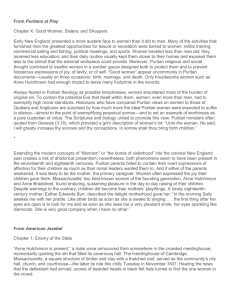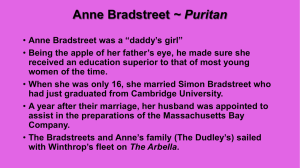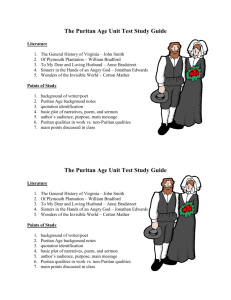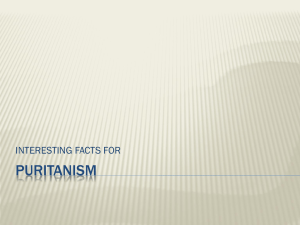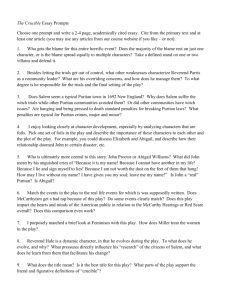Puritan Women
advertisement
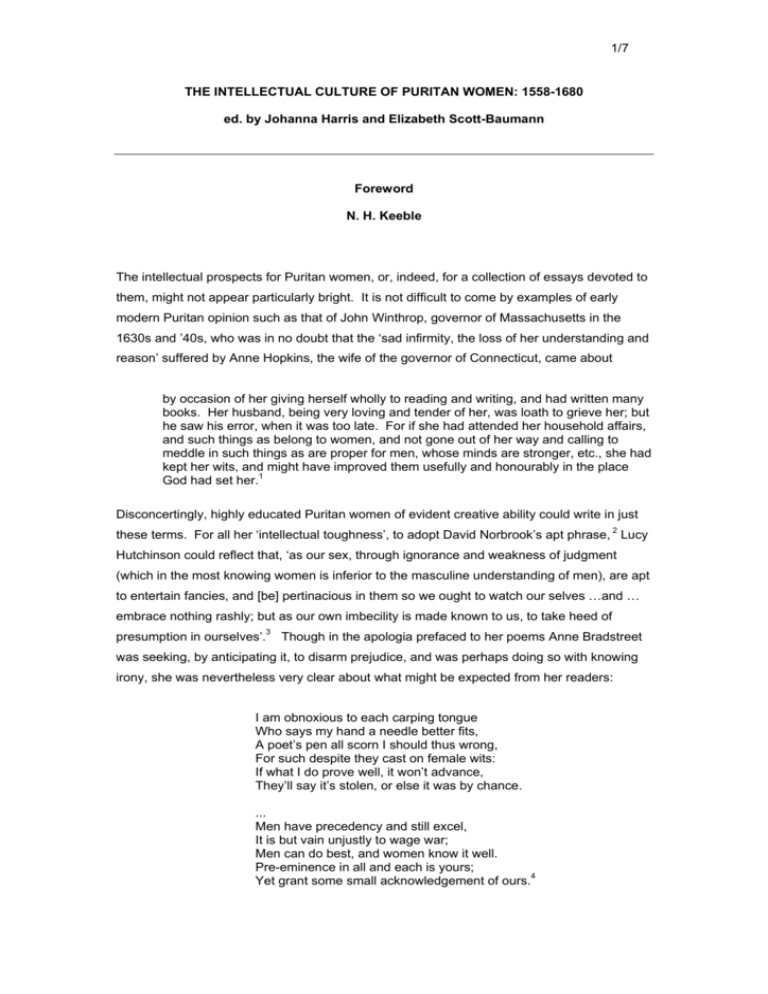
1/7 THE INTELLECTUAL CULTURE OF PURITAN WOMEN: 1558-1680 ed. by Johanna Harris and Elizabeth Scott-Baumann Foreword N. H. Keeble The intellectual prospects for Puritan women, or, indeed, for a collection of essays devoted to them, might not appear particularly bright. It is not difficult to come by examples of early modern Puritan opinion such as that of John Winthrop, governor of Massachusetts in the 1630s and ’40s, who was in no doubt that the ‘sad infirmity, the loss of her understanding and reason’ suffered by Anne Hopkins, the wife of the governor of Connecticut, came about by occasion of her giving herself wholly to reading and writing, and had written many books. Her husband, being very loving and tender of her, was loath to grieve her; but he saw his error, when it was too late. For if she had attended her household affairs, and such things as belong to women, and not gone out of her way and calling to meddle in such things as are proper for men, whose minds are stronger, etc., she had kept her wits, and might have improved them usefully and honourably in the place God had set her.1 Disconcertingly, highly educated Puritan women of evident creative ability could write in just these terms. For all her ‘intellectual toughness’, to adopt David Norbrook’s apt phrase, 2 Lucy Hutchinson could reflect that, ‘as our sex, through ignorance and weakness of judgment (which in the most knowing women is inferior to the masculine understanding of men), are apt to entertain fancies, and [be] pertinacious in them so we ought to watch our selves …and … embrace nothing rashly; but as our own imbecility is made known to us, to take heed of presumption in ourselves’.3 Though in the apologia prefaced to her poems Anne Bradstreet was seeking, by anticipating it, to disarm prejudice, and was perhaps doing so with knowing irony, she was nevertheless very clear about what might be expected from her readers: I am obnoxious to each carping tongue Who says my hand a needle better fits, A poet’s pen all scorn I should thus wrong, For such despite they cast on female wits: If what I do prove well, it won’t advance, They’ll say it’s stolen, or else it was by chance. ... Men have precedency and still excel, It is but vain unjustly to wage war; Men can do best, and women know it well. Pre-eminence in all and each is yours; Yet grant some small acknowledgement of ours.4 2/7 Small wonder that it is Eve’s asking questions that causes much of the trouble in Paradise Lost. And yet, when Eve leaves Adam and Raphael to talk together of things ‘abstruse’, the narrator of Paradise Lost is careful to insist that ‘went she not as not with such discourse/ Delighted, or not capable her ear/ Of what was high’.5 It is a seemingly small chink of light, but by it the essays in this collection are able to illuminate for the first time a vista of quite extraordinary breadth, richness and variety, and one which our commonplaces (derived from witnesses such as Winthrop) about patriarchal oppression, discriminatory gender roles, strategies of subversion and passive subjects are quite unable to chart. Far from being isolated, untutored, idiosyncratic or marginalised,6 the women described in these essays take their due place in a wide range of intellectual, cultural, social, religious and literary networks. These include Anne Locke’s association with John Knox and the Presbyterian and Genevan reformers of Elizabeth’s reign; the part played by Mary Herbert, Countess of Pembroke, in the Sidney circle; the engagement of Lucy Russell, Countess of Bedford, both in the courtly activities of late Elizabethan and early Stuart England and in international Protestant networks; the involvement of Katherine Jones, Viscountess Ranelagh, in the Hartlib circle and her association with the pioneering experimental scientists who would constitute the Royal Society; and the radical sectarians and printers, and the gathered churches, of Anna Trapnell’s London. There is nothing apologetic or deferential about these engagements, nor the least suggestion of impropriety or inequality. On the contrary, these women are not merely participants in, but are influential members of, their intellectual and cultural circles. Lady Ranelagh enjoyed the admiration and respect of continental (male) members of the Hartlib circle without condescension or concession. Carrying, in its prefatory epistle, the explicit approval of Matthew Parker, Archbishop of Canterbury, the translation of John Jewel’s foundational Apologia Ecclesiae Anglicanae by Anne, Lady Bacon (1564) constituted the officially sanctioned publicly accessible defence of the newly re-established Protestant Church of England. It was through a woman that the episcopal English church found its national voice. Furthermore, her probable patronage and facilitation of, if not active involvement in, the compilation of A Parte of a Register (1593), an apologetic collection of cases of persecution, established an enduring tradition of Puritan record-keeping that led to the later detailed archives assembled by the Quakers. It is from these accumulative habits that modern archival practice and notions of historical evidence developed. There are many such examples in these essays of Puritan women being in the intellectual vanguard and of their assuming the roles of patron, mentor and guide. By John Knox’s own account, Anne Locke acted as his spiritual mother. Lady Ranelagh exercised the authority of a recognised leader within the Hartlib circle. Mary, Lady Vere, was the patron of many Puritan clerics, including James Ussher, whose consecration as archbishop of Armagh 3/7 was largely owing to her good offices. She was, in return, the dedicatee of books by eminent Puritan ministers, as was the Countess of Bedford of a number of theological works. In a very different context, Jonson and Donne enjoyed her patronage, receiving in return, from Donne, praise as ‘God’s masterpiece, and so/ His factor for our loves’.7 Different again, yet comparable in its demonstration of superior status within cultural communities, was the sway exercised over their followers by the prophetess Anna Trapnell and by the mystic Jane Lead. If the cultural authority and extensive social and intellectual networks of these women are striking, so too is the comprehensiveness of their learning. Not only records such as the commonplace book of Brilliana, Lady Harley, or the library catalogues of the Harleys and of Elizabeth Isham (reproduced below),8 but the literary models, conventions and allusions of their texts demonstrate a familiarity with the entirety of Europe’s Classical, Christian, Humanist and Reformation heritage: Greek and Latin poets and philosophers; the Church Fathers; Italian and French Renaissance writers; Lutheran and Reformed theologians; systematic, evangelistic, controversial, casuistical and practical works by English Puritan divines; and Tudor and Stuart poets and dramatists – all are in attendance. Any of these women might aptly have said, with Anne, Lady Southwell, ‘I by booke haue trauelld all the world’.9 If our expectations of early modern gender, cultural and social distinctions are unsettled by these essays, so, too, are our generic assumptions. Received literary categories and hierarchies hardly apply. Though we are beginning to learn that Renaissance culture is not susceptible to Enlightenment orderliness, nor containable within would-be scientific taxonomies or confident critical definitions, one of the revelations of the following essays is just how ill-equipped we remain to encompass the fluidity and flexibility of early modern intellectual exchange, discourse and productivity. Letters, which we pigeonhole as private and personal communications between friends and relatives, probably inconsequential, illconsidered and ephemeral, were for Lady Harley and for Lady Vere their chief means of intellectual exchange, essential to the maintenance and coherence of the godly community of which they were part. It was similarly through correspondence that the members of the Hartlib circle, including Lady Ranelagh, maintained their international network and developed their pansophical programme. For the Countess of Pembroke, translation was not subordinate to original creativity, as we are inclined to judge it, but its vehicle. Her compositional practices cannot be adequately contained within notions of revision and completion, nor of sole or collaborative authorship. Jane Lead’s habit of serial composition is similarly teasing to expectations of textual closure. The flexibility of Anne Locke’s conception of literary kinds could accommodate original sonnets within her translation of Calvin without compromising her work’s integrity. Elizabeth Melville’s refashioning of Petrarchanism to religious purpose dissolves the distinction between divine and profane, while for Lady Southwell humane artistry is itself an image, reflection and expression of divine creativity, of 4/7 the revealed truth that ‘with retorick is sweetly grased/ … a grammar of congruitye’.10 In autobiographical writing such as Elizabeth Isham’s ‘Book of Rememberance’, creative, devotional and meditative practices are so inextricably interdependent as to render insufficient (and impossible) any attempt to read the text as solely a literary exercise. Similarly, Anne Bradstreet’s shorter poems are as prayerful as they are poetic, and the title-page of Lucy Hutchinson’s Order and Disorder describes that poem as ‘Meditations upon the Creation and the Fall; As it is recorded in the beginning of Genesis’.11 In short, our familiar binary oppositions fail us: private/public, original/imitative, print/manuscript, secular/sacred, finally, even masculine/feminine. Our own intellectual and critical tools are rendered dull by the vibrancy, excitement and adventurousness of the intellectual culture of Puritan women. And yet, for all this wonderful richness and diversity, every one of the essays in this collection examines what remain recognisably Puritan works. As the historian Geoffrey F. Nuttall long ago taught us, Puritanism is not to be defined by any one set of doctrinal, ecclesiological or liturgical practices or convictions, still less by cultural or political affiliations;12 it is compatible with, and articulated through, the whole range of opinion current in the early modern period. Lucy Hutchinson’s republicanism is no more definitive of Puritanism than is Margaret Fox’s Quakerism or the Presbyterianism of Elizabeth Melville - or, indeed, Winthrop’s masculinism, which is why he proves such an unreliable guide. For all this variety, however, something discernibly distinctive is shared: a high seriousness of purpose founded not on the externalities of a particular religious or political allegiance - Milton’s (Puritan) God preferred before ‘Before all temples th’upright heart and pure’13 – but on a piercingly honest subjectivity: ‘Awake my soule, my conscience knockes, awake’. As Southwell’s injunction suggests, Puritan self-scrutiny and self-awareness14 results not in introspective retreat but, founded on the sure ground of self-knowledge, vocational action; she continues: ‘cast of this stupid lethargie of sense/ …& bee noe longer bogg<e>’d in diffidence’.15 In one of the poetic self-admonitions of the nonconformist Julia Palmer, the womanly reticence so admired of Winthrop is, strikingly, stigmatised as culpable, a reprehensible refusal of Christian responsibility: What means this sinfull. modesty Which maketh me, most times, soe shy To speak how good thou art … Who wilt thou speak for, oh my soull If not for him, whose thou art whole Why then art thou so loth For to begin To speak of him And set his glory forth16 So far from being unseemly, ‘Spiritual discourse’ (in the words of the poem’s title) is for her, as for all Christians, a duty. Whatever their kind, the writings examined in this symposium constitute an active ministry of letters: ‘Everie one in his calling’, wrote Anne Lock, ‘is bound 5/7 to doo somewhat to the furtherance of the holie building’ of ‘that Jerusalem, wherof (by grace) wee are all both Citizens and members’.17 6/7 NOTES 1 John Winthrop, Journal (13 April 1645), in Perry Miller & Thomas H. Johnson (ed.), The Puritans, 2 vols. (1938; rev. edn. New York: Harper & Row ,1963), 1:140. 2 Lucy Hutchinson, Order and Disorder, ed. David Norbrook (Oxford: Blackwell, 2001), p. xvi. 3 Lucy Hutchinson, On the Principles of the Christian Religion, ed. Julius Hutchinson (London, Longman, 1817), p. 5-6. 4 Anne Bradstreet, ‘The Prologue’, ll. 27-32, 40-4, in The Works, ed. Jeannine Hensley (Cam., Mass.: Harvard University Press, 1967), p. 16. 5 Paradise Lost, 8: 39-50. 6 As the editors of this collection note, early modern women writers are often so characterised (below, p. 00). 7 John Donne, ‘To the Countess of Bedford (Madam,/ Reason is our soul’s left hand, Faith her right)’, ll.33-4, in John Donne, The Complete Poems, ed. A. J. Smith (Harmondsworth: Penguin, 1971), p. 224. 8 See pp. 00-00. 9 Jean Klene (ed.), The Southwell-Sibthorpe Commonplace Book (Tempe: Medieval and Renaissance Texts and Studies, 1997), p. 137 (quoted below, p. 00). 10 Klene (ed.), Southwell-Sibthorpe Commonplace Book, p. 69 (quoted below, p. 00). 11 Hutchinson, Order and Disorder, p. lx. 12 Geoffrey F. Nuttall, The Puritan Spirit (London: Epworth Press, 1967). 13 Milton, Paradise Lost, 1:18. 14 It is no accident that many compounds in self in English are Puritan coinages; see Marinus van Beek, An Enquiry into Puritan Vocabulary (Groningen: Wolters-Noordhoff, 1969), pp. 68-9, 117-20. 15 Klene (ed.), Southwell-Sibthorpe Commonplace Book, p. 128. 16 Julia Palmer, ‘About spirituall discourse June 13 72’, in The ‘Centuries’ of Julia Palmer, ed. Victoria Burke and Elizabeth Clarke (Nottingham: Nottingham Trent University, 2001), p. 156. 7/7 17 Anne Vaughan Lock, The Collected Works, ed. Susan M. Felch (Tempe: Medieval & Renaissance Text Society, 1999), p. 77 (quoted below, p. 00).
